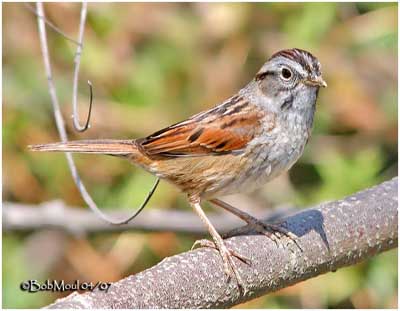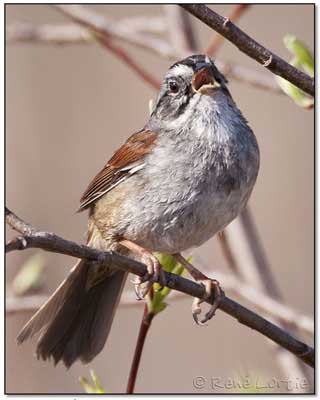
Swamp Sparrow
Zonotrichia georgiana
Passeriforme Order – Passerellidae Family
BIOMETRICS:
Length: 12-14 cm
Wingspan: 18-19 cm
Weight: 11-24 gr
LONGEVITY: Up to 6 years
DESCRIPTION:
Swamp Sparrow shows considerable variations in crown colour. Males have brighter crowns than females, overall in breeding season, when males have completely rusty crowns, and females have brown striped crowns.
PROTECTION / THREATS / STATUS:
The populations of Swamp sparrows appear to have held stable or increased slightly in the last century. Swamp Sparrow populations depend on wetland conservation.
The predators of Swamp Sparrows include cats, dogs, diurnal and nocturnal raptors, and rodents.
Fr: Bruant des marais
All : Sumpfammer
Esp : Sabanero Platanero
Ital: Passero delle paludi
Nd: Moerasgors
Russe: Болотная зонотрихия
Sd: Träsksparv
Photographs by René Lortie
His website : http://rlortie.ca/
Photographs by Bob Moul
His website : Nature Photography
Text by Nicole Bouglouan
Sources :
FIELD GUIDE TO THE BIRDS OF NORTH AMERICA - National Geographic Society - ISBN: 0792274512
A GUIDE TO THE BIRDS OF MEXICO AND NORTHERN CENTRAL AMERICA by Steve N. G. Howell, Sophie Webb - Oxford University Press - ISBN: 0198540124
All About Birds (Cornell Lab of Ornithology)
Bird Web (Seattle Audubon Society)
South Dakota Birds and Birding (Terry L. Sohl)
What Bird-The ultimate Bird Guide (Mitchell Waite)
Birds of Nova Scotia (Robie Tufts)

Swamp Sparrow has grey face and supercilium, a black streak extended behind eye. Throat is white with dark malar streak.
Back is black and buff streaked, wings are rusty, breast is grey. Flanks are buffy with indistinct streaks, belly is whitish. Tail is thin and rounded.
It has a conical bill. Legs and feet are pinkish brown. Eyes are brown.
Both sexes are similar except the crown.
Juvenile in summer is similar to adult, but is buffer and streakier underneath.
VOICE: SOUNDS BY XENO-CANTO
Swamp Sparrow has a sweet, musical trill, all on one note. Its trilling song is typically loud, slow and musical. Call note is a metallic “chip”.
HABITAT:
Swamp Sparrow lives in wetland and open water. We can find it in freshwater marshes, and open wooded swamps, wet meadows and brushy edges of streams and ponds. During the migrations, it prefers weedy fields and parks.
RANGE:
Swamp Sparrow breeds in Canada and the northern regions of eastern and central North America. It winters in south-eastern North America and Mexico.
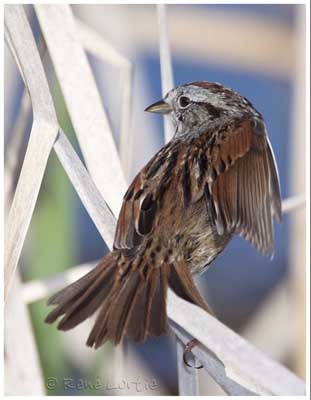
BEHAVIOUR:
Swamp Sparrow feeds mostly from the ground, and along the edge of water. It picks up invertebrates from the mud and the surface.
They have longer legs than other sparrows, which allow them to wade through very shallow water, to search for food. They may even put their head under water to catch aquatic invertebrates. They also forage in the dense wetland vegetation.
Swamp Sparrow is rather shy, but responds readily to any squeaking noise. It is never seen in large flocks, but is usually found singly, foraging on the ground in rather dense cover. If disturbed, it often runs away on the ground like a mouse.
Male regularly sings from prominent perches throughout is territory. It will sing day or night in breeding season.
One of the main factors affecting nesting success is water level. If a very rainy summer occurs, flooding can destroy nests which are built close to the ground.
FLIGHT:
Swamp Sparrow is a short distance migrant. Except during migration, a Swamp Sparrow rarely flies more than a few dozen yards at a time, and rarely flies higher than a few feet above the grass top. Its flight is characterized by the tail pumping up and down.
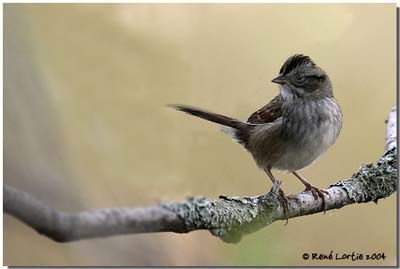
REPRODUCTION:
Swamp Sparrow’s nest is built by female. It is a bulky open cup, made with coarse grass, sedges, cattails, twigs and rootlets, and lined with fine grass and plant down. The entrance of the nest is usually on the side.
It’s usually situated low above the ground, or over water in dense cattails, grass or shrubs, or sometimes on the ground and concealed from above by vegetation, or hidden in dense tussock or marsh vegetation.
Female lays 4 to 5 bluish white eggs, spotted black and brown. Incubation lasts about 12 to 15 days, by female, while male feeds her at nest. Chicks hatch helpless with sparse dark brown down. Both parents feed the nestlings. They fledge at 9 to 11 days after hatching, but they don’t fly very well for another 2 or 3 days.
Swamp Sparrow pairs produce 2 broods per year.
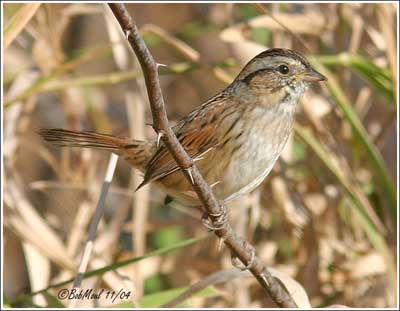
DIET:
Swamp Sparrow feeds mostly seeds of sedges and weeds, fruits and aquatic invertebrates. It picks beetles, ants, crickets and other insects off the surface. In summer, its diet is 90% insects and small invertebrates. Young are fed with insects.
